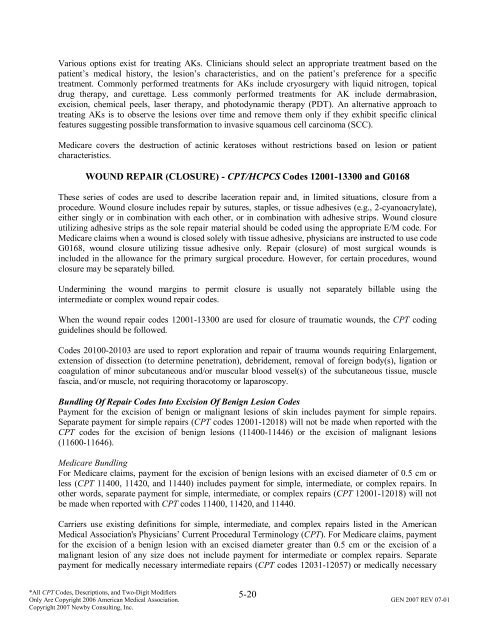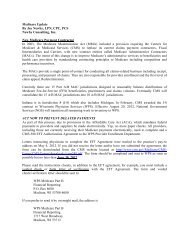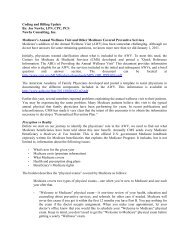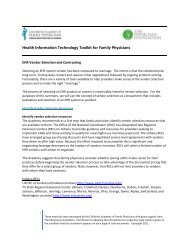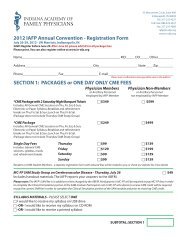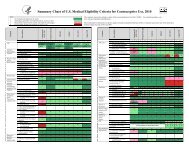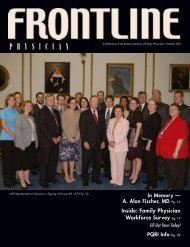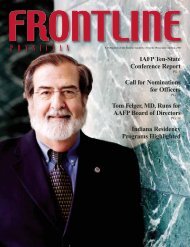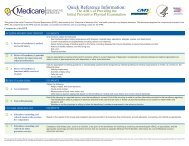pqri measure coding and reporting principles - Indiana Academy of ...
pqri measure coding and reporting principles - Indiana Academy of ...
pqri measure coding and reporting principles - Indiana Academy of ...
Create successful ePaper yourself
Turn your PDF publications into a flip-book with our unique Google optimized e-Paper software.
Various options exist for treating AKs. Clinicians should select an appropriate treatment based on the<br />
patient’s medical history, the lesion’s characteristics, <strong>and</strong> on the patient’s preference for a specific<br />
treatment. Commonly performed treatments for AKs include cryosurgery with liquid nitrogen, topical<br />
drug therapy, <strong>and</strong> curettage. Less commonly performed treatments for AK include dermabrasion,<br />
excision, chemical peels, laser therapy, <strong>and</strong> photodynamic therapy (PDT). An alternative approach to<br />
treating AKs is to observe the lesions over time <strong>and</strong> remove them only if they exhibit specific clinical<br />
features suggesting possible transformation to invasive squamous cell carcinoma (SCC).<br />
Medicare covers the destruction <strong>of</strong> actinic keratoses without restrictions based on lesion or patient<br />
characteristics.<br />
WOUND REPAIR (CLOSURE) - CPT/HCPCS Codes 12001-13300 <strong>and</strong> G0168<br />
These series <strong>of</strong> codes are used to describe laceration repair <strong>and</strong>, in limited situations, closure from a<br />
procedure. Wound closure includes repair by sutures, staples, or tissue adhesives (e.g., 2-cyanoacrylate),<br />
either singly or in combination with each other, or in combination with adhesive strips. Wound closure<br />
utilizing adhesive strips as the sole repair material should be coded using the appropriate E/M code. For<br />
Medicare claims when a wound is closed solely with tissue adhesive, physicians are instructed to use code<br />
G0168, wound closure utilizing tissue adhesive only. Repair (closure) <strong>of</strong> most surgical wounds is<br />
included in the allowance for the primary surgical procedure. However, for certain procedures, wound<br />
closure may be separately billed.<br />
Undermining the wound margins to permit closure is usually not separately billable using the<br />
intermediate or complex wound repair codes.<br />
When the wound repair codes 12001-13300 are used for closure <strong>of</strong> traumatic wounds, the CPT <strong>coding</strong><br />
guidelines should be followed.<br />
Codes 20100-20103 are used to report exploration <strong>and</strong> repair <strong>of</strong> trauma wounds requiring Enlargement,<br />
extension <strong>of</strong> dissection (to determine penetration), debridement, removal <strong>of</strong> foreign body(s), ligation or<br />
coagulation <strong>of</strong> minor subcutaneous <strong>and</strong>/or muscular blood vessel(s) <strong>of</strong> the subcutaneous tissue, muscle<br />
fascia, <strong>and</strong>/or muscle, not requiring thoracotomy or laparoscopy.<br />
Bundling Of Repair Codes Into Excision Of Benign Lesion Codes<br />
Payment for the excision <strong>of</strong> benign or malignant lesions <strong>of</strong> skin includes payment for simple repairs.<br />
Separate payment for simple repairs (CPT codes 12001-12018) will not be made when reported with the<br />
CPT codes for the excision <strong>of</strong> benign lesions (11400-11446) or the excision <strong>of</strong> malignant lesions<br />
(11600-11646).<br />
Medicare Bundling<br />
For Medicare claims, payment for the excision <strong>of</strong> benign lesions with an excised diameter <strong>of</strong> 0.5 cm or<br />
less (CPT 11400, 11420, <strong>and</strong> 11440) includes payment for simple, intermediate, or complex repairs. In<br />
other words, separate payment for simple, intermediate, or complex repairs (CPT 12001-12018) will not<br />
be made when reported with CPT codes 11400, 11420, <strong>and</strong> 11440.<br />
Carriers use existing definitions for simple, intermediate, <strong>and</strong> complex repairs listed in the American<br />
Medical Association's Physicians’ Current Procedural Terminology (CPT). For Medicare claims, payment<br />
for the excision <strong>of</strong> a benign lesion with an excised diameter greater than 0.5 cm or the excision <strong>of</strong> a<br />
malignant lesion <strong>of</strong> any size does not include payment for intermediate or complex repairs. Separate<br />
payment for medically necessary intermediate repairs (CPT codes 12031-12057) or medically necessary<br />
5-20<br />
*All CPT Codes, Descriptions, <strong>and</strong> Two-Digit Modifiers<br />
Only Are Copyright 2006 American Medical Association. GEN 2007 REV 07-01<br />
Copyright 2007 Newby Consulting, Inc.


